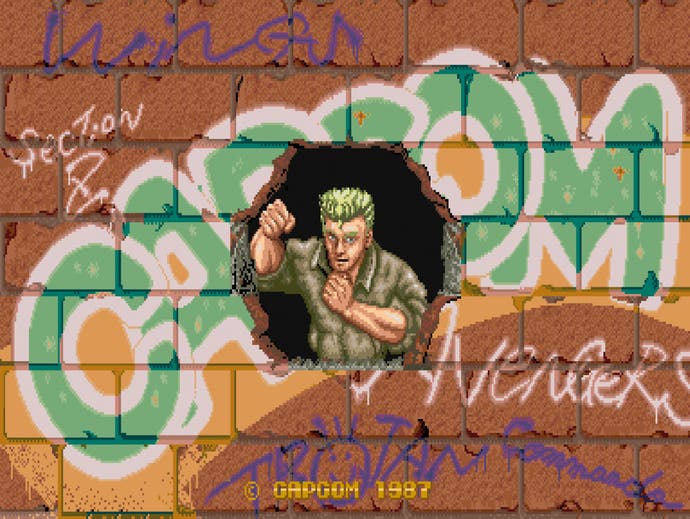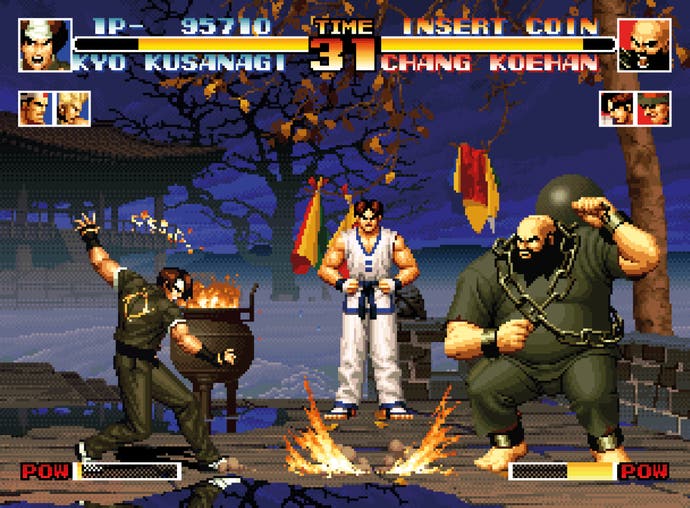Birth of the cool: How The King of Fighters came to be
The ultimate history of an iconic series.
There was something special about SNK in the 90s, a swagger and style in the Osaka-based outfit's output that lent its games a unique sense of cool. At the heart of all that was The King of Fighters, perhaps SNK's most iconic series and one that endures to this day. Bitmap Books has recenly put together a comprehensive history of the series, amply illustrated by some fine artwork and never before seen concept and design documents, and have kindly agreed to publish the below excerpt telling the story behind The King of Fighters' genesis.
The history of KOF actually begins long before Kyo Kusanagi first stepped into the fighting arena in 1994. In fact, the game's lineage can be traced all the way back to founding fighting game titles from the '70s and '80s, such as Heavyweight Champ, Champion Boxing and Karate Champ, the latter of which was a major influence on the seminal arcade classic Street Fighter, released in 1987.
Street Fighter was the brainchild of Takashi Nishiyama, who cut his teeth at Japanese gaming firm Irem on fighting-filled beat-'em-up titles such as Kung-Fu Master and Avengers. After moving to Capcom, he joined forces with friend and colleague Hiroshi Matsumoto to create what would become one of the most influential fighting game series of all time.
Indeed, Street Fighter was the title that introduced many of the fighting game staples that now underpin the genre, with the game being the first in the genre's history to introduce command-based special moves, such as the now famous Hadōken and Shōryūken attacks. It also pioneered the use of a six-button control scheme, with each player having access to three punch buttons and three kick buttons.
Not long after Street Fighter hit the arcades, Nishiyama and Matsumoto joined the up-and-coming gaming hardware and software firm SNK. They immediately began work on two titles that would have a huge influence on the KOF series. Those titles were the legendary SNK fighting game classics Fatal Fury: King Of Fighters and Art Of Fighting, which, both directly and indirectly, would be key elements in the fiery crucible in which KOF was born.
But those events still lay in the future, and before they could take place, a whole new roster of characters needed to be introduced.

Takashi Nishiyama has confirmed that the blond fighter seen punching a hole in the wall in the intro to Street Fighter is indeed the basis for the character who would become the legendary Terry Bogard in Fatal Fury.
The director of KOF '94 grew up loving Japanese anime, such as Tensai Bakabon, Ashita no Joe, Tiger Mask and Devilman, as well as arcade and Super Famicom games. After working for a while on package design for electronic products, he decided that he would leave this 'black industry' (so named for its low pay and long hours) and pursue a different career in the still fledgling video game industry.
"I had never really considered working at a game company," the KOF '94 director recalls, "and considered games to be something to be enjoyed, not a creative output, but my friends seemed to be having fun. I happened to see a job opening at Irem and I felt that I could use my skills, so I applied for the job."
The KOF '94 director's first project at Irem was Air Duel, where he worked alongside future Metal Slug director Kazuma Kujo; the KOF '94 director was tasked with handling the design of backgrounds, bosses and the game's title screen. As anyone who has played that title will know, the KOF '94 director's quality was evident right from the start. But, as he candidly admits, his own talent was boosted by assistance from a famous sensei.

The Ikari Warriors stage from KOF 94, and a typically lush backdrop for an SNK fighter.
"Six months after I entered Irem, I won a game industry design award for my graphics work on Air Duel, which surprised even me. I won 6th place in the industry among the hundreds of arcade games released in that year. Back in the day, it wasn't like people would take you by your hand and teach you methods or whatever. It was highly inefficient. I happened to sit in a seat right in front of Akio Oyabu of Metal Slug, who's a world class designer.
"There's a Japanese saying, 'Stealing work from over the shoulder', and I would literally turn around whenever Oyabu-san would go on a smoke or bathroom break, and look at his work and then copy it, and that's how I learned how to be a good designer. If I'd been seated even two seats over, I might not have been so lucky or won the award that I did. I was very lucky to be sitting that close to Oyabu-san."
Despite this early recognition, within a year of joining Irem and completing Air Duel, the KOF '94 director found himself leaving the firm altogether for pastures new. The catalyst for him leaving? None other than Takashi Nishiyama, who, upon leaving Capcom for SNK, turned to his old stomping ground, Irem, to recruit talent to work with him on new projects.
"I was actually headhunted by Nishiyama-san, head of development at SNK," recalls the KOF '94 director. "He picked a handful of people from Irem to join him."
Whether the KOF '94 director knew it or not, Nishiyama was building a team from inside and outside of SNK who, during their careers, would work on many now-classic NEOGEO games as well as launch the KOF series.

One of that team was the future main planner of KOF '94, Masanori Kuwasashi, who, like the KOF '94 director, had grown up watching anime such as Space Battleship Yamato and playing video games in the arcades. When Nishiyama joined SNK, Kuwasashi, inspired by the work of a now-famous source, was already there.
"When I was in high school I had an opportunity to make a movie with my friends, and that got me into thinking that I would like to go to school to pursue making films, considering my fascination with science fiction and action movies, things like that. There's a famous director named Hideaki Anno who is now known for his work on Neon Genesis Evangelion. He studied at the Visual Concept Planning Department of Osaka University of Arts, where they teach students how to make movies. I really liked his work so I followed his footsteps to become a director and get into the entertainment industry.
"At the school, they had a recruiting event, and there were a lot of video game companies there recruiting students. I thought that the video game industry would also be an interesting place to tell stories. I applied to a few video game companies and got hired at SNK. That was how I got into the industry."
What's even more interesting to gaming fans and, arguably, to the narrative of the creation of KOF, is just how SNK recruited much of its new staff back in the '80s and early '90s, which is something Kuwasashi recalls vividly.
"SNK had an exam for all new hires to take, whether you were a programmer or designer or planner. The test was mostly design-focused problems, like drawing a background. Then they'd have some elementary math problems. That must have been a minimum math ability requirement.
"You see, back then the game industry itself was still quite young. Even within SNK, including arcades, there were only a handful of people who maybe had around ten years of experience. So their strategy was to recruit young people and build their workforce rather than bring people in from outside with experience, because there weren't a lot of people out there from middle management anyway."
While the KOF '94 director's first title at SNK had been Last Resort, Kuwasashi cut his teeth on the classic NEOGEO sports title Baseball Stars Professional, as its planner.
"Baseball Stars Professional was the first game I was involved with from beginning to end, so I was able to learn the fundamentals of game development, how many people are required to make what parts, who exactly is involved, that sort of thing. It was enjoyable, but it was definitely not easy." Toyohisa Tanabe, who would become lead planner on five KOF games, also remembers how he moved to SNK at this time, shedding even more light on how the pioneering gaming firm operated back then.
"I was born in Hiroshima and came up to Osaka to study how to become an artist, but found there wasn't a lot of work to make a living in that way. Through looking for work as an artist, I came across game development. I liked games, of course, but hadn't initially considered becoming an artist for games. When I realised they were hiring - games obviously need some kind of art - I became intrigued by the game industry and applied to SNK's job postings. I took the exam, which I passed, and that's how I got into the game industry."
As for that SNK exam, Tanabe also has vivid recollections of just what it took to get involved at SNK.
"It was a basic entrance exam that asked the sort of foundational questions you would see at any company, but there was a 30-minute-to-an-hour section of the exam that asked us to do an illustration. I really liked Gundam and drawing robots, so I remember really quickly drawing a robot character.
"There were some questions that were typical of Japanese entrance exams. They also had some questions testing us on our knowledge of video games. At the time Dragon Quest was really popular, and there was an essay question asking, 'Why do you think Dragon Quest is so popular, what do you think is the secret to its success?' That sort of thing. That's what I remember from the entrance exam. So, I think there were three parts to the exam: typical entrance exam questions, knowledge of the industry, and drawing skills."
Despite getting into SNK while young, Tanabe, like the KOF '94 director, was still very much learning his trade on the job; the gaming industry was still so new that there was little formal or ad hoc training, or hardware available for those who wanted to get involved. If you wanted to make games then your route into the industry was far less clear than it is today.
"Our generation learned and developed our skills while we moved through our careers, alongside the rapid increase of technology in the game industry," Tanabe confirms.
This is something that future lead programmer on KOF '94, Shinichi Shimizu, agrees with, noting that, "Back then there weren't any specialised school programmes for game programming."
Shimizu, whose first project at SNK was working with both Kuwasashi and Tanabe on Baseball Stars Professional, also had to pass SNK's entrance exam, which he recalls as, "A written exam where we had to write out programming code from scratch. I wrote it out in the assembler language with the assembler program." Despite their lack of formal training, the KOF '94 director, Kuwasashi, Tanabe and Shimizu - under the stewardship of Nishiyama - would go on to form the core of one of the most pioneering, bold and, if truth be told, fearless game development teams of all time.
This was a team that would take rivalries within SNK to a new level and square off against competing firms like Capcom and SEGA at the absolute height of their powers.
Thanks again to Bitmap Books for supplying the excerpt. You can order The King of Fighters: The Ultimate History from Bitmap Books' official site.


